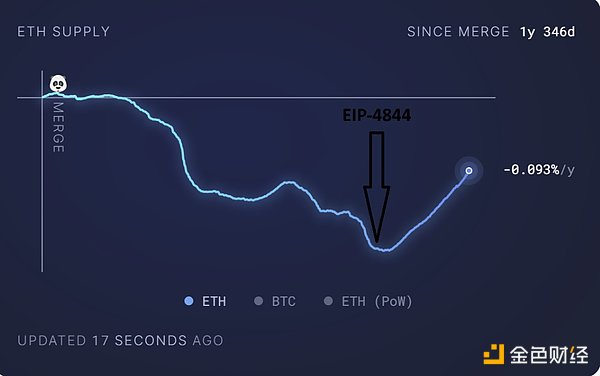Author: Justin Bons, Founder of Cyber Capital Source: X, @Justin_Bons Translation: Shan Ouba, Golden Finance
Ethereum (ETH) is facing a thorny problem: it can't maintain high fee income because it lacks the ability to scale. At the same time, usage and fees on layer 2 networks (L2) are hitting record highs, while these networks are constantly lobbying to reduce ETH's capacity. This situation has gradually evolved into a parasitic relationship that is eroding the foundation of ETH.
Imbalance between fee income and inflation
Since EIP-4844 (Proto-Danksharding), Ethereum's fee income has dropped significantly. The reason is simple: the L2 network is collecting all the fees. Because of this, fee consumption can no longer keep up with inflation. L2 gradually took over transaction execution, causing Ethereum's inflation rate to remain high, far exceeding previous levels.

The rise of L2 has not only divided the entire Ethereum ecosystem into competing camps, but also broken liquidity and composability, causing the ecosystem to become fragmented. Given the economic incentives of L2, solutions like shared sorting are simply not feasible in reality, just like L1 expansion. This series of problems pushes users to highly centralized L2.
L2 Centralization and Governance Dilemma
Today, the top ten L2s are likely to steal user funds and conduct censorship. Ironically, when Ethereum first formulated the "L2 expansion" roadmap, it was rationalized in the name of decentralization. The reality is that this approach ends up being a bait and switch that puts Ethereum in a centralized decision-making process. The only result of the Ethereum community's complete rejection of on-chain governance is that ETH development is effectively centralized.
As L2 currencies gradually dominate the ETH ecosystem, returning to L1 scaling has become impossible. In a hypothetical scenario, even if ETH achieves L1 scaling through new technological breakthroughs, all L2 token and equity prices will collapse overnight, becoming obsolete and useless. L2 is actually stealing ETH users and fees, pretending that they are "one" with ETH, but this is far from the truth. At best, they are competitors, and at worst, this is a vampire attack that slowly drains the life out of ETH.
The Future of L2 and ETH
If L2 continues to migrate or directly becomes the new L1, Ethereum will inevitably decline. This is why, in some cases, we are bullish on L2 over ETH. ETH is sacrificing itself for L2, even if it hurts the crypto-punks. Ironically, ETH is repeating the mistakes of BTC, embarking on the same path of corruption and capture, exposing systemic problems in governance.
ETH currently has little hope of recovery because its leadership has compromised with L2. Any effort to scale ETH will undermine the capital and fees earned by L2, and venture capital cannot benefit from the expansion of L1. These parasites distort public resources into a rent-seeking platform for venture capital chains, seriously damaging the long-term development of Ethereum.
Conclusion
In the current situation, Ethereum is undergoing a profound internal struggle. The rise of L2 seems to bring convenience to users, but in fact it is eroding the foundation of Ethereum. The ETH community must re-examine the on-chain governance and expansion roadmap to avoid an irreversible decline.
 Bitcoinworld
Bitcoinworld
 Bitcoinworld
Bitcoinworld Bitcoinworld
Bitcoinworld Coinlive
Coinlive  CryptoSlate
CryptoSlate Coindesk
Coindesk Bitcoinist
Bitcoinist Cointelegraph
Cointelegraph Cointelegraph
Cointelegraph Cointelegraph
Cointelegraph Cointelegraph
Cointelegraph